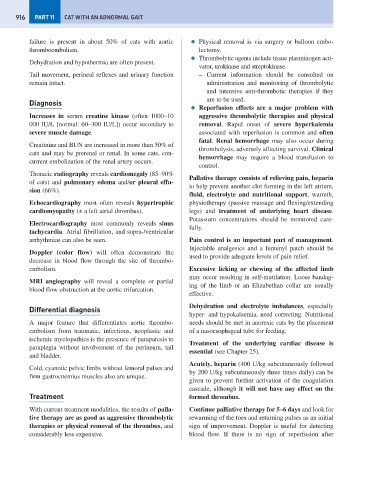Page 924 - Problem-Based Feline Medicine
P. 924
916 PART 11 CAT WITH AN ABNORMAL GAIT
failure is present in about 50% of cats with aortic ● Physical removal is via surgery or balloon embo-
thromboembolism. lectomy.
● Thrombolytic agents include tissue plasminogen acti-
Dehydration and hypothermia are often present.
vator, urokinase and streptokinase.
Tail movement, perineal reflexes and urinary function – Current information should be consulted on
remain intact. administration and monitoring of thrombolytic
and intensive anti-thrombotic therapies if they
are to be used.
Diagnosis
● Reperfusion effects are a major problem with
Increases in serum creatine kinase (often 1000–10 aggressive thrombolytic therapies and physical
000 IU/L [normal: 60–300 IU/L]) occur secondary to removal. Rapid onset of severe hyperkalemia
severe muscle damage. associated with reperfusion is common and often
fatal. Renal hemorrhage may also occur during
Creatinine and BUN are increased in more than 50% of
thrombolysis, adversely affecting survival. Clinical
cats and may be prerenal or renal. In some cats, con-
hemorrhage may require a blood transfusion to
current embolization of the renal artery occurs.
control.
Thoracic radiography reveals cardiomegaly (85–90%
Pallative therapy consists of relieving pain, heparin
of cats) and pulmonary edema and/or pleural effu-
to help prevent another clot forming in the left atrium,
sion (66%).
fluid, electrolyte and nutritional support, warmth,
Echocardiography most often reveals hypertrophic physiotherapy (passive massage and flexing/extending
cardiomyopathy (± a left atrial thrombus). legs) and treatment of underlying heart disease.
Potassium concentrations should be monitored care-
Electrocardiography most commonly reveals sinus
fully.
tachycardia. Atrial fibrillation, and supra-/ventricular
arrhythmias can also be seen. Pain control is an important part of management.
Injectable analgesics and a fentenyl patch should be
Doppler (color flow) will often demonstrate the
used to provide adequate levels of pain relief.
decrease in blood flow through the site of thrombo-
embolism. Excessive licking or chewing of the affected limb
may occur resulting in self-mutilation. Loose bandag-
MRI angiography will reveal a complete or partial
ing of the limb or an Elizabethan collar are usually
blood flow obstruction at the aortic trifurcation.
effective.
Dehydration and electrolyte imbalances, especially
Differential diagnosis
hyper- and hypokalaemia, need correcting. Nutritional
A major feature that differentiates aortic thrombo- needs should be met in anorexic cats by the placement
embolism from traumatic, infectious, neoplastic and of a nasoesophageal tube for feeding.
ischemic myelopathies is the presence of paraparesis to
Treatment of the underlying cardiac disease is
paraplegia without involvement of the perineum, tail
essential (see Chapter 25).
and bladder.
Acutely, heparin (400 U/kg subcutaneously followed
Cold, cyanotic pelvic limbs without femoral pulses and
by 200 U/kg subcutaneously three times daily) can be
firm gastrocnemius muscles also are unique.
given to prevent further activation of the coagulation
cascade, although it will not have any effect on the
Treatment formed thrombus.
With current treatment modalities, the results of palla- Continue palliative therapy for 5–6 days and look for
tive therapy are as good as aggressive thrombolytic rewarming of the toes and returning pulses as an initial
therapies or physical removal of the thrombus, and sign of improvement. Doppler is useful for detecting
considerably less expensive. blood flow. If there is no sign of reperfusion after

